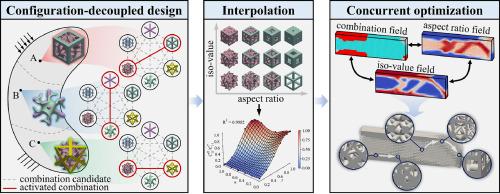Configuration-decoupled concurrent topology optimization of heterogeneous lattice structures
IF 7.3
1区 工程技术
Q1 ENGINEERING, MULTIDISCIPLINARY
Computer Methods in Applied Mechanics and Engineering
Pub Date : 2025-09-24
DOI:10.1016/j.cma.2025.118405
引用次数: 0
Abstract
Multi-configuration lattice structures have recently been introduced into structural optimization due to their broadly tunable physical properties. Traditional methods for multi-configuration lattice optimization employ extreme strategies of complete fusion or separation, leading to a trade-off between optimality and scalability that has not been fully addressed in the existing literature. The paper suggests decomposing the lattice library into pairs of lattices, through which multi-configuration lattice optimization is decoupled into the concurrent optimization of iso-value, combination category, and ratio within combination. A novel hybrid interpolation scheme is proposed to describe the effective mechanical behavior of the configuration-decoupled lattices. In this approach, polynomial models are employed to characterize the performance of individual lattice combinations, while the Uniform Multiphase Materials Interpolation model is used to integrate the contributions of all combinations. Benchmark experiments, including full-scale simulations, are conducted to validate the effectiveness of the framework. The proposed method enables rapid convergence to configuration layouts that align with the principal stress orientations. Compared to single- and dual-configuration designs, it achieves compliance reductions of 61.0 % and 26.2 %, respectively, approaching the performance of density-based topology optimization. Extended numerical experiments reveal the joint influence of resolution and configuration count on the overall performance. This method achieves a better trade-off between optimality and extensibility, enabling more flexible utilization of large lattice databases in practical engineering fields.

异构晶格结构的构型解耦并发拓扑优化
由于其广泛可调的物理性质,多构型晶格结构最近被引入到结构优化中。传统的多构型晶格优化方法采用完全融合或分离的极端策略,导致在最优性和可扩展性之间进行权衡,这在现有文献中尚未得到充分解决。提出将格库分解为格对,将多构型格优化解耦为同值优化、组合范畴优化和组合内比值优化。提出了一种新的混合插值方法来描述构型解耦格的有效力学行为。在这种方法中,多项式模型被用来表征单个晶格组合的性能,而均匀多相材料插值模型被用来整合所有组合的贡献。基准实验,包括全尺寸模拟,进行了验证框架的有效性。提出的方法能够快速收敛到与主应力方向一致的配置布局。与单配置和双配置设计相比,它的遵从性分别降低了61.0%和26.2%,接近基于密度的拓扑优化的性能。扩展的数值实验揭示了分辨率和配置计数对整体性能的共同影响。该方法在最优性和可扩展性之间取得了较好的平衡,使大型点阵数据库在实际工程领域的应用更加灵活。
本文章由计算机程序翻译,如有差异,请以英文原文为准。
求助全文
约1分钟内获得全文
求助全文
来源期刊
CiteScore
12.70
自引率
15.30%
发文量
719
审稿时长
44 days
期刊介绍:
Computer Methods in Applied Mechanics and Engineering stands as a cornerstone in the realm of computational science and engineering. With a history spanning over five decades, the journal has been a key platform for disseminating papers on advanced mathematical modeling and numerical solutions. Interdisciplinary in nature, these contributions encompass mechanics, mathematics, computer science, and various scientific disciplines. The journal welcomes a broad range of computational methods addressing the simulation, analysis, and design of complex physical problems, making it a vital resource for researchers in the field.

 求助内容:
求助内容: 应助结果提醒方式:
应助结果提醒方式:


